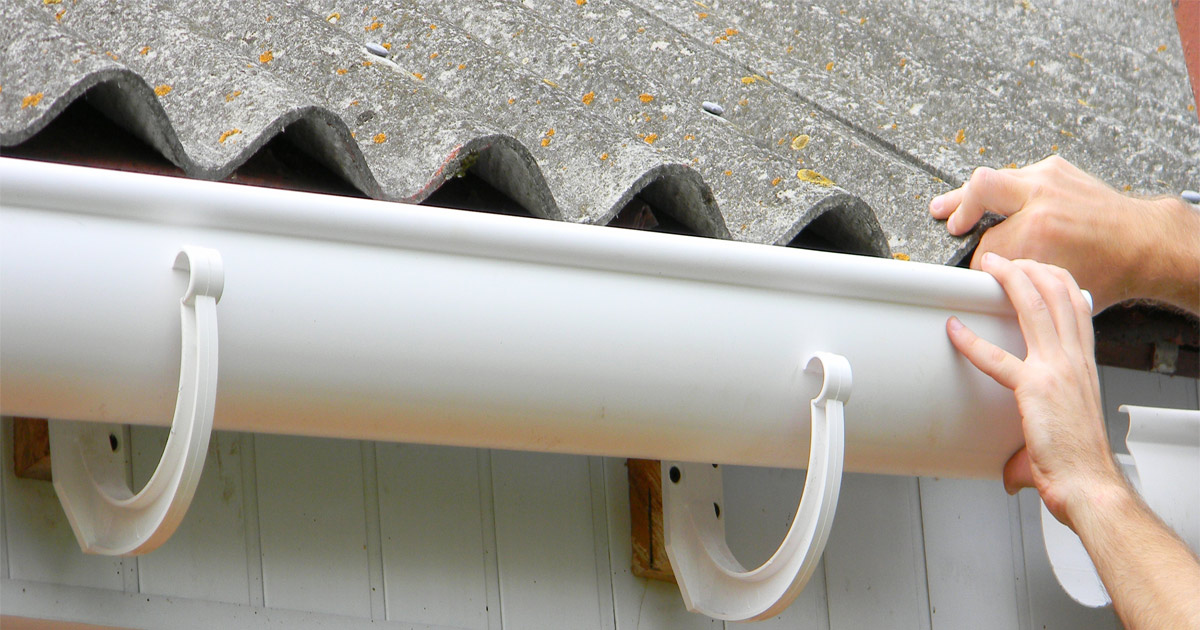A profession with the greatest risk of falls at work from dangerous heights are roof contractors installing gutters. Like roofers and contractors who use high ladders at work, roof contractors who install and service gutters work under dangerous conditions that subject them to the dangers of falling from heights, resulting in severe work injuries, also classified as a slip & fall work accident. Additionally, on average, more than 200 construction workers are killed every year from slip & fall work accidents from dangerous heights. The following are major causes of workplace slip and fall injuries from high heights:
Lack of slip & fall protection: Since work falls are the cause of the most serious roofing and gutter accidents, fall protection should be in-place for employees working at dangerous heights. The three major methods of fall protection include guard rails, safety nets, and personal fall arrest systems.
Unstable ladder usage: A ladder must be set up on a stable and secure surface or it will pose a risk of falling sideways or sliding away from the building. According to the U.S. Consumer Products Safety Commission, around 165,000 work injuries result each year from improper use of ladders, including 90,000 injuries that require a visit to the emergency room.
Use of improper safety equipment: Use an appropriately sized ladder for the job. A ladder that extends to the proper height is the only way to safely access the workspace for the job. In addition, weight restrictions and other limitations for the safe use of ladders should be considered.
Hazardous substances: Mold from rotting materials and sharp debris present roofing dangers. Additionally, small animals or insects may make their homes in clogged gutters.
Power line dangers: Electrical wires that run from the streets into homes and buildings can cause electrocution hazards for anyone who encounters them.
Poor scrutiny of jobsite hazards: Supervisors and safety managers should survey the entire jobsite to identify potential dangers. Work hazards cannot be mitigated if they go unnoticed or unassessed. Once hazards are recognized, protections should be put in place to keep employees safe while they work.
Inadequate training: It is vital that employers provide adequate training to teach their employees how to protect themselves. In addition to demonstrations and implementation of safety measures, employers must ensure that proper safety measures are being used on every job.
How to Prevent Work Injuries While Working on a Roof?
Clean the surface of the roof: Keeping roofs clear of debris, such as sticks and leaves, is essential to keeping the roof safe for workers to walk on the surface of the rooftop without tripping or slipping. Cleaning the roof of natural waste has the added bonus of allowing the gutters to work properly, as they are less likely to become clogged and ineffective.
Wear proper footwear: Supportive boots or sneakers with rubber soles will offer the best traction on the surface of a roof. When it comes to providing grip for a worker navigating the terrain of a sloped or uneven roof, rubber soles provide protection against slip and falls.
Protect hands with thick gloves: Sharp metal gutters present a danger of cuts and gashes. When cleaning built-up debris from gutters, gloves can protect hands from sharp sticks and other objects, as well as any dangerous bacteria, animal droppings, or other harmful substances. A gutter scoop may also be useful to keep hands safe.
OSHA Requirements
The Occupational Safety and Health Administration (OSHA) has created a list of requirements to protect workers who perform duties at heights that present serious injuries from falls. The agency calls for the implementation of three preferred techniques to protect employees from falls, as well as several supportive methods to enhance protections or to be used when the preferred methods are impractical. OSHA’s preferred systems to protect workers from falls from heights include:
Guardrails: Surrounding the edge of the jobsite, guardrails extend to about 42 inches high. This metal rail can help make employees aware of where the edge of the roof comes in, which is a helpful visual aid. This is in addition to the possibility of physically saving a person from falling, as the guardrail must be able to withstand a force of 200 pounds.
Safety nets: Made of rope mesh or other strong material, safety nets keep workers who fall off a roof from hitting the ground. These nets are installed no more than 30 feet under the work surface. The nets must be strong enough to catch a falling person and must be inspected regularly for damage.
Personal fall arrest systems: A personal fall arrest system uses a harness, a lifeline, and a fixed anchor to tether a worker to the roof to prevent falls. These systems, which must be able to withstand 5,000 pounds of force and be made of sever-resistant materials, are recommended for anyone working at heights above six feet. Employers should train workers on their safe use.
Secondary Protection
In addition, OSHA provides guidance for the use of methods that can offer secondary protection when other systems are used, or that can be used in place of the systems mentioned above when those preferred methods cannot be employed as a workable solution to the issue of fall safety. Unlike major protection techniques, which offer protection inherent in their design, the following secondary methods require active measures from employees to be effective:
Controlled access zones: Areas that are unable to be protected using the three major fall protection systems should be restricted to only authorized personnel. The area can be cordoned off with rope, caution tape, or some other material to notify people to keep out of the area.
Safety monitoring: With this method, one person on a work team should be in charge of monitoring the jobsite and work practices for fall safety. The safety monitor should remain on the same elevated work surface as the team members whose fall safety is being monitored and remain close enough to be able to offer verbal warnings when a worker comes too close to the edge or other danger.
Warning line systems: Ropes, wires, or chains can be used to create barriers to notify workers that they are approaching the roof edge. Placed at least six feet from the edge, the warning lines should surround the entire work area. This fall prevention method does not meet OSHA standards on its own; it must be used in conjunction with safety monitoring or one of the three major systems.
Hole covers: Holes in floors and roofs are a common danger that cause fall injuries. When a hole is present, it should be covered enough to support twice the weight placed on it. Fall prevention should include ensuring that the cover is secure, as well as making the cover stand out by using a color-coded warning system or marking it to bring attention to the hazard.
Workers’ Compensation
If a worker was denied coverage for an accidental fall that occurred while they were working to install or clean a gutter as part of their job, they should be covered by their employer’s workers’ compensation insurance policy. The claim should offer compensation for the work accident, including payments for medical bills and lost wages, among other possible benefits. A knowledgeable workers’ compensation lawyer can review each case and advise on the next best steps.
Cherry Hill Workers’ Compensation Lawyers at Pietras Saracino Smith & Meeks, LLP Represent Workers Injured While Installing or Cleaning Gutters
If you were injured in a work accident, contact the Cherry Hill workers’ compensation lawyers at Pietras Saracino Smith & Meeks, LLP. We will review your case and obtain the compensation you deserve for your injuries. Contact us online or call 856-761-3773 to schedule a free consultation today. Located in Cherry Hill, New Jersey, we provide legal services to clients throughout South Jersey, including Camden, Cinnaminson, Delran, Maple Shade, and Pennsauken.







